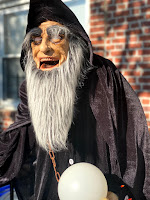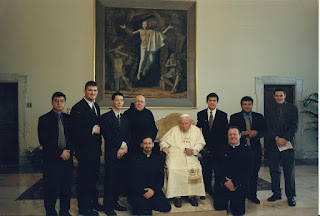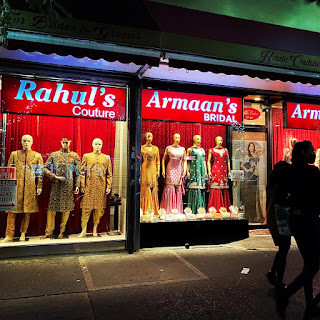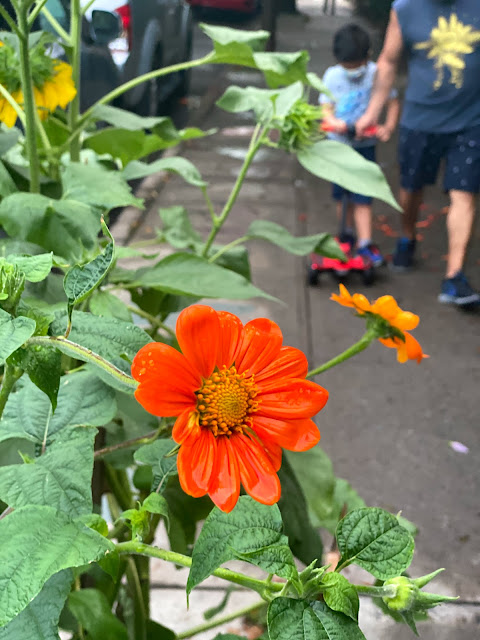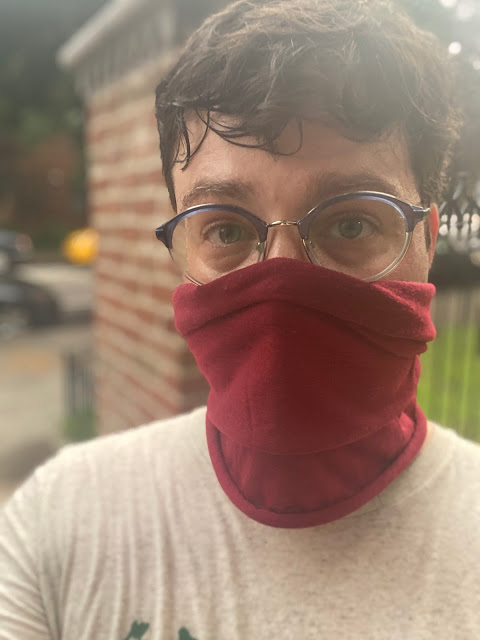Stones of Erasmus — Just plain good writing, teaching, thinking, doing, making, being, dreaming, seeing, feeling, building, creating, reading
17.11.20
Video Repost: Teen Entrepreneurs Start Their Own Trash Bin Cleaning Service Called The Wash Broz
 I am an educator and a writer. I was born in Louisiana and I now live in the Big Apple. My heart beats to the rhythm of "Ain't No Place to Pee on Mardi Gras Day". My style is of the hot sauce variety. I love philosophy sprinkles and a hot cup of café au lait.
I am an educator and a writer. I was born in Louisiana and I now live in the Big Apple. My heart beats to the rhythm of "Ain't No Place to Pee on Mardi Gras Day". My style is of the hot sauce variety. I love philosophy sprinkles and a hot cup of café au lait.
31.10.20
All Hallows' Eve in Greenwood Cemetery and Sunset Park, Brooklyn (Special 2020 Halloween Post)
In this post, I regale you with pictures and musing from an All Hallows' Eve visit to Greenwood Cemetery and Sunset Park, Brooklyn. It was a beautiful Autumn Day and we are all cognizant of the need to physical-distance ourselves — so what better way to do that than to be outdoors in a massive cemetery?
Exploring Greenwood Cemetery on All Hallows’ Eve, I scored a handful of great photographs. Located in South Brooklyn, the cemetery is one of the oldest graveyards in the city and is a site of a Revolutionary War battle. @historicgreenwood is also a National Historic Landmark. My friends John and Jennifer joined me; we also went to Sunset Park, my old neighborhood. Scarfed down a torta stuffed with spicy pork at @tacoselbronco, scored a free beer from a passerby, and watched the D train come out of the tunnel on Fourth Avenue — it was a serendipitous day.


 I am an educator and a writer. I was born in Louisiana and I now live in the Big Apple. My heart beats to the rhythm of "Ain't No Place to Pee on Mardi Gras Day". My style is of the hot sauce variety. I love philosophy sprinkles and a hot cup of café au lait.
I am an educator and a writer. I was born in Louisiana and I now live in the Big Apple. My heart beats to the rhythm of "Ain't No Place to Pee on Mardi Gras Day". My style is of the hot sauce variety. I love philosophy sprinkles and a hot cup of café au lait.
25.10.20
On How To Meet a Pontiff (Or, That Day I Attended a Private Audience with John Paul II)
 |
| When I was a Roman Catholic Seminarian, and the very young age of nineteen, I was in a private audience with the then Pontiff of the Roman Catholic Church, John Paul II |
To say that I met and chatted with the leader of the Roman Catholic Church would be a stretch. But I did kiss his ring. And I got to see him in his private chapel and in his private library in the Vatican.
I attended a private audience with about twenty-five other people — mostly priests and seminarians. It was the year 2000—around Christmas time—and I was in Rome with other American seminarians from the American College in Leuven, Belgium (where I was a college seminarian at the Catholic University of Leuven). At the time I was studying to be a priest, and our group was invited to have a private audience. The story went that when John Paul II was a seminarian in Krakow, Poland, his seminary was suppressed by the Nazis and apparently, the American College, in Leuven, had sent over, secretly, supplies, books, and the sort, to Poland, as a sign of support and solidarity.
We were in Rome for two weeks, staying as a guests at the Pontifical North American College (located on the Janiculum hill) — but we didn't know what day our audience would happen. There are security protocols one follows when scheduled to meet the Pope. The Vatican gave a call to our group leader, a Benedictine priest named Aurelius Boberek, the night before and he then contacted us to be on the ready. We're meeting the pope!
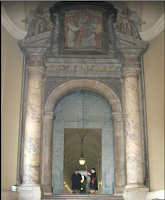 |
| The Bronze Doors |
John Paul II had a private chapel in the papal apartments, located in the upper floors of what is officially called the Palace of Sixtus V, where he celebrated an early mass. It was so quiet when we arrived one could hear a pin drop. The Pope enters the sanctuary fully vested and he celebrated the Mass in the old Latin rite style — facing the altar (and not facing the people). I think I read one of the readings for the Mass (Or, maybe I read the intercessions. I cannot remember, exactly). So did my classmate Brent Necaise, who was a student with me — I was from Louisiana and he was from Mississippi). Afterward, the Pope's private secretary, a fellow by the name of Stanislaus Dziwisz, escorted us to the private study (or was it the library?) of the Pope.
It was Christmas time, so in the Pope's library there was a stately Christmas tree with ornaments painted with images of John Paul II. I remember thinking that was funny for some reason. I guess if you are Pope you get used to seeing your image affixed to everything from postage stamps, money, and ornaments. I remember all of the furniture was elegant but not overstated. It was a brightly lit room. And there was a wooden barrister bookcase with nicely appointed leather-bound books.
The Pope entered shortly after we had congregated and took a seat in a white plush chair. Everyone in our group lined up to meet him one by one, by kissing his ring, and stating our home state in the United States. When it was my turn he said softly, "Oh. The Mardi Gras," because it was announced I was a seminarian from Louisiana, and when another seminarian said he was from Kentucky he said, "Oh. Race horses." And it went like that — and each of us received a rosary and a holy card.
The picture I have of the event, where I am actually greeting the Pope (see above), is not the best — because it's a photo I took much later of a framed copy of the photograph that my aunt has hanging in her house in Covington, Louisiana. She was always proud of my decision to go to the Seminary — and I think she still has the picture hanging in her living room.
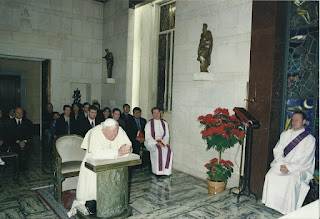 |
| Inside the Pope's private chapel in the Apostolic Palace |
Stray Observations
- The bronze door to the Apostolic Palace is really cool. It's massive! A Swiss Guard stands by to protect the entrance. There is a long hallway (which, as I stated above, was designed by Raphael) and to the right an ornately designed staircase that takes you up to the levels of the Apostolic Palace.
- I remember the Pope's chapel had an image of the Polish version of the Virgin Mary — entitled Black Madonna of Częstochowa.
- John Paul II was about eighty-years old when I visited him in the Vatican and he had already been pope for about twenty-two years.
- The pope would die about five years after the above photograph was taken.
- When I was in Rome to visit the Pope, it was a hectic time for me. I was studying philosophy at the Catholic University of Leuven in Belgium — sent there on a scholarship from my home diocese in Louisiana, under the auspices of the Benedictines, of whom I was a student scholastic) and I was living at the American seminary (located at 100 Naamsestraat). We traveled to Rome and were visitors to the Pontifical North American Seminary in Rome. I was also hosting my cousin and my mother — who were in Rome at the same time as me. I was juggling doing seminary stuff, keeping up with my studies, and playing host to my visiting family. I remember it was all very hectic, very "sturm and drang"!
- We got lost in Rome several times! The streets wend this way and that. My mother hurt her ankle because we walked so much.
- My favorite place in the Vatican is the necropolis of Saint Peter (also called "The Scavi". Buried under Saint Peter's Basilica, it is an ancient Roman cemetery. The story goes that when the Apostle Peter was crucified in the first century by the Romans, the site where the Vatican now sits was a Roman Circus. After Peter's death, nailed to an upside-down crucifix, he was hastily buried on the Vatican Hill by his friends so his body would not be pecked away by predator birds. Christians revered the site, and built a church near his grave. Hence, the reason why the Church in Rome grew up around this spot. It is possible to visit it but it takes a lot of planning and scheduling to get tickets. It's called "The Scavi Tour." You literally go underneath the ground and voilà you are suddenly in the site of the ancient cemetery. It is a bedazzling adventure, for sure.
- When in Rome — do as the Romans do and have dinner at 9:00 in the evening and a glass of red wine with a serving of very thin pizza.
 I am an educator and a writer. I was born in Louisiana and I now live in the Big Apple. My heart beats to the rhythm of "Ain't No Place to Pee on Mardi Gras Day". My style is of the hot sauce variety. I love philosophy sprinkles and a hot cup of café au lait.
I am an educator and a writer. I was born in Louisiana and I now live in the Big Apple. My heart beats to the rhythm of "Ain't No Place to Pee on Mardi Gras Day". My style is of the hot sauce variety. I love philosophy sprinkles and a hot cup of café au lait.
20.10.20
How Diligence Paid Off Cataloging Indigenous Plant Species of Louisiana (And How I Came Upon the Secret of Motivation)
In this post, I wax nostalgic about a class I took in high school and how it taught me something about human motivation.
"You'll need to collect one-hundred specimens of native flora from Louisiana to gain a perfect score for this project," intoned our Biology teacher — I was in Eleventh grade. I had opted to take a class called Biology II rather than Environmental Science. It was unlike me. Having gravitated more to the arts and humanities, even in high school, taking an advanced science class went against the grain. But it was one of the most immersive courses I took in high school. I liked the botany unit. We had an entire semester devoted to exploring indigenous plant species of Louisiana. I had even gone as far as to purchase a used copy of a field guide to plants of the state; "Don't collect invasive species," our teacher had said. So I wanted to make sure I knew the difference between Kudzu and an indigenous Wood Sorrel.
 |
| Look around you. There is a world to catalog and discover. |
What drives motivation? What made me so motivated to pursue a task that before I had taken it, I would never have followed on my own? Most likely, it was the challenge of the project. Something about discovery: and the idea that I had to explore areas outside the boundaries of my neighborhood or looked closely at the familiar. I don't remember what my classmates did for the project; I don't recall working with a partner.
I had my parents purchase for me a ginormous three-pronged binder and a bunch of styrene protective covers. To successfully save a plant specimen, it is necessary to place the plant parts into a book or under a newspaper fastened with something heavy — like a book or a rock. It can take days for the specimen to set properly — our teacher had specifically said that if you don't let the plant sufficiently dry out — it will rot and produce mold once you seal it in the binder covering. The first few plants I had picked out delivered such a fate — I didn't press them long enough — so afraid of having points deducted from my project, I did them over again.
I was diligent and methodical with this project — I managed to collect about ninety-eight specimens — everything from Sweet Bay Magnolia to a Pitcher Plant. I noticed how invasive species could completely take over an area, their massive and quick growth, quickly suffocating plant diversity in the area. This specific invasive plant called Chinese Privet — I found lots of those everywhere around my backyard. Seeing the ubiquity of certain herbaceous plants made me realize the destructive force of nature when human intervention is too rapid, and Mother Nature cannot keep up.
Motivation is tied to relevance. If you can tap into the significance of a task, then you have your student's attention. Make a task too easy, and it loses its relevance; make a task unattainable, and it becomes a chore. I like how my teacher implied that the project had a perennial aspect to it; I still have that binder from high school. And I still have the plant species; they are labeled correctly and nicely preserved.
It wasn't an easy task, but it promised discovery. So finding a rare plant species proved to me a gleeful moment — filled with joy, as on a particular jaunt into the woods behind my mother's house in Madisonville, Louisiana — I found a Devil's Walking Stick — properly named because if you pluck it you will automatically be stung by its many sharp prongs that line its length. Walking deep into the woods, I came across a bayou that flooded its waters often when rain fell heavily, which gradually seeped back into the ground or wended its way back to a tributary and then into the Tchefuncte River and then finally into Lake Pontchartrain, which is an estuary that opens out into the Gulf of Mexico. Everything is connected. I knew then and know now.
As a teacher myself, I now give students projects and written assignments, as one is wont to do as a teacher. I have never given out a botany project like the one my science teacher did for us — but I marvel at what motivated me to complete such a project so painstakingly. I sometimes joke with colleagues that if someone were to crack the code of what truly motivates people to be industrious, creative, or simply do work — especially work that at first glance does not seem necessary — they ought to win some kind of Nobel Prize for Ingenuity. I never went into Botany — heck, in college, I only took a handful of Science classes. The bulk of my undergraduate course load was filled to the brim with Dante and Kazuo Ishiguro — with ample servings of Plato, Aristotle, Thomas Aquinas and Shakespeare — can you tell I went to a heavily Western-centric liberal arts college? But I never forgot my foray into botany. That project stayed with me over the years. I still remember the scientific names of certain plant species — for example, Live Oaks and White Oaks — and all oaks — belong to the Quercus genus. And figs are in the ficus family. And if you take a walk with me in the woods, I will revel in the joy of discovering a field of Crimson Clover — it's still a beautiful flower.
 I am an educator and a writer. I was born in Louisiana and I now live in the Big Apple. My heart beats to the rhythm of "Ain't No Place to Pee on Mardi Gras Day". My style is of the hot sauce variety. I love philosophy sprinkles and a hot cup of café au lait.
I am an educator and a writer. I was born in Louisiana and I now live in the Big Apple. My heart beats to the rhythm of "Ain't No Place to Pee on Mardi Gras Day". My style is of the hot sauce variety. I love philosophy sprinkles and a hot cup of café au lait.
25.9.20
Street Photography: 74th Street in Jackson Heights, Queens (Plus Some Creative Writing)
What was supposed to be a walk to increase my daily steps turned into a journey. People pop out. Restaurants offer outside seating. The night is crisp. Saturn and Jupiter are still visible in the sky — on the way to convergence. I wanted to get more faces in my photographs. But the moments passed by too quickly. I saw a masked guy in a cab. He was balefully looking out a window. The Q49 bus runs along 74th Street. Wear your mask.
Today in class an adolescent pupil couldn’t answer a question — so she said to me, “This question makes me feel unsafe.” I was taken aback by her statement. It’s the Covid. I imagined her shrieking out of class. By an unsafe question. I’m teaching a course on mythology. And one characteristic of myth is the unknown. So I get it, girl. Stuff gets real. From chaos to calm. From the womb to the tomb.
 I am an educator and a writer. I was born in Louisiana and I now live in the Big Apple. My heart beats to the rhythm of "Ain't No Place to Pee on Mardi Gras Day". My style is of the hot sauce variety. I love philosophy sprinkles and a hot cup of café au lait.
I am an educator and a writer. I was born in Louisiana and I now live in the Big Apple. My heart beats to the rhythm of "Ain't No Place to Pee on Mardi Gras Day". My style is of the hot sauce variety. I love philosophy sprinkles and a hot cup of café au lait.
19.9.20
Travel Diary: Jones Beach in September (When Jupiter and Saturn Are Visible in the Evening Sky)
Where setting sun meets lapping waves — John, a friend, and colleague who is an amateur weather guy, tells me that the cloud formation in the sky is from weather pushing inland, effects of hurricane formation in the Atlantic, and today’s low dew point (which makes for a gorgeous day to be outside). Jupiter and Saturn are visible in the sky, and the moon is a thin crescent. Waves crash on shore — moving in a sweeping longitudinal motion. I almost get wet, and I marvel at the enthusiasm of seagulls. Which picture do you like best?
 I am an educator and a writer. I was born in Louisiana and I now live in the Big Apple. My heart beats to the rhythm of "Ain't No Place to Pee on Mardi Gras Day". My style is of the hot sauce variety. I love philosophy sprinkles and a hot cup of café au lait.
I am an educator and a writer. I was born in Louisiana and I now live in the Big Apple. My heart beats to the rhythm of "Ain't No Place to Pee on Mardi Gras Day". My style is of the hot sauce variety. I love philosophy sprinkles and a hot cup of café au lait.
12.9.20
First Days of School in the Covid-19 Era — Report from a High School English Teacher
Some schools have already been back in session for three weeks now and New York City Public schools have not even started but in our small school in Jackson Heights — we just started this past week. Here's my first day of school report — 2020 edition.
Deep Thought Freeze Frame on Zoom
"I think she's in deep thought," a curly-haired kid in the front row said. "But's she's been like that for a long time." I checked the computer screen — a laptop on the teacher's desk where I could see kids that were learning remotely from home. "Can she hear us?" I asked. ""I think she's frozen, Mr. Roselli." And sure enough, she was. Whatever she needed to say was caught out of joint, still.
That's a snapshot of my first couple of days back at school. I am a high school English teacher at a private school in New York City. About twelve percent of the school has chosen to go remote. The rest of us are at school, wearing masks, properly podded in classrooms, with orchestrated arrival and dismissal times, lunch delivered to classrooms, temperature checks, and everyone in the building has been tested for Covid-19.
A Kind Eighth Grader and a Lesson on Lipids
I start my day before school checking my devices, making sure I don't have a laptop or Chromebook at a low battery level. "Make the first days of school fun," a friend says. But it doesn't feel fun. The excitement of the first day lost its allure this year. In homeroom, I take attendance, but I have to make sure the students who are learning remotely have logged on. Then I have a planning period in the morning. And then, I monitor the eighth-grade study hall. "How are you doing, Mr. Roselli?" one of the eighth-graders asked me, and my heart melts a little bit because I know this kid, and I was touched by her small gesture of empathy. She tells me in a free flow of words how her day has gone, her troubles with Google Classroom, and why soap and water kill the Coronavirus. The whole class then suddenly stops and listens as I give a deliberate explanation of how the cell wall of a coronavirus is made of a lipid layer — and that soap is basically a lipid — and when soap hits the surface of your skin, any virus material that may be on it gets canceled out by lipid action. Soap is basically fat. I say.
After lunch, I teach three classes back-to-back, and they are all in separate rooms with a different technology set-up. One place is near the main hallway, and it has a blackboard only, a teacher's desk that I won't need to use, a bunch of maps (that I won't use), and no smartboard. There's a laptop hooked up to the Internet, and I sign into the school Zoom account to admit the remote learners into the room. I tell the kids who are actually in the classroom, "While I set up Zoom open up Google Classroom on your device. Respond to the group discussion question, and we'll get started in five minutes." I had forgotten that over the Summer, I had made "podcasts" to go along with some of my lessons. I am kinda glad I did because it's given me a sense of control of my courses. One of my students, a quiet kid who always answers my questions correctly, but I cannot understand him (because he speaks very softly), is sitting in the front row listening to one of the podcasts. I hear my own voice emanate, and it feels surreal. "That's Mr. Roselli's voice. Do you like the sound of your own voice?" No, not really, I think to myself.
A Feeling of Split-Screen Reality
There's me in the room, kids in the room, devices, a chalkboard, kids on Zoom — and I forgot to take the daily attendance. So I open a new tab on the same laptop that's streaming the Zoom, and I realize I need to log-in again — but I don't have my password handy, so I take out my phone that has all of my passwords. But I am wearing a mask, and the phone prompts to login me in with face recognition. But I don't have time to lower my mask for the phone to capture an image of my face. So then I need to key in the phone's password. And by this time, I feel that tinge of stress that radiates from your neck down the small of your back. Too much cognitive functioning going on!
I jump back again to reality — by saying, "Let's talk about representation." A brunette girl who had been listening intently to my audio says, "Yeah. Like politics." And we talk about how senators or representatives represent us in Congress. But I explain that in Art History "representation" has a slightly different meaning. And then I feel like the class flow is streaming (and no one is frozen on Zoom). But then I want to show the class a painting of Pocahontas that was done in 1616 that depicts her as a European — when in fact, she was an indigenous person.
So I pull that up — but then I realize, "Wait. The kids at home cannot see it." So I need to share my screen. And then I feel stressed out again. For some reason, I cannot share my screen — and I promise to put the picture on Google Classroom later so everyone can see it. Later, when I add the graphics, I notice that in my Twelfth Grade English class a boy named Adam has posted, "Let's get it, Mr. R.! Keep it up with the same energy!"
Why You Have So Many Websites?
If a kid thinks I have a surplus of energy, I think, let's get it, then. The last two periods of the day go well — it's sometimes funny to see how the kids on Zoom interact with the kids in the classroom. I make a joke with the class about how I feel like the kids on Zoom are not really real — because they are postage-stamp-sized moving images — a bit pixelated and blurry. But there are real kids in the room. And they are like kids. Feeling anxious and worried and also a bit expectant about the beginning of the school year.
I don't like this set-up. It makes me feel inadequate. It's a compromise — to open school, and to allow options for kids who want to stay at home. But it's going to run me down to the ground if I don't devise a plan.
So, first. I am going to keep up the idea of making podcasts. They are easy to make, and they help me as a teacher to organize my thoughts for each lesson. In March and April, I listened to a ton of podcasts, and they helped me get through the darker days of the pandemic. So I want to recreate that immersive experience of listening to someone's voice.
"Why so many websites?" a sixteen-year-old boy asked me, with a tee-shirt that said "Phoenicia" on it. I didn't understand his question, so I asked him to explain. "Oh. He said. Like you have so many websites on your Google Classroom." I realized what he meant. I have a website for the class, and then there is the Google Classroom page, and I use Vocaroo for my podcasts, and Quizlet for flashcards and FlipGrid for presentations — it all becomes quite intense quickly. I’m suddenly feeling I could use a vacation in Phoenicia right about now.
Your Class Feels Like A Lot. Because It Is
Over the Summer, I didn't know what I would be teaching until late August. And once I found out what my course load was to be, I immediately started planning the year. In the Eleventh Grade English class that I teach, I have thirteen weeks of material already set up. I thought it would make me feel organized — and it did! I do not regret doing it — but one of my students, an awesome kid, said, "You have thirteen weeks already set up. That's a lot. This class is going to be a lot."
And I guess she's right. It feels like a lot this year. That's why I had fun on Friday doing an activity where I had asked everyone to send me in advance a "fun fact" about themselves that no one knows about so we could share it in a fun lesson at school. "I have a Guinea Pig,"; "Follow me on YouTube,"; "I want to be a recording artist,"; "I want to be a Psychology and Business major,"; “I hiked the southern rim of the Grand Canyon when I was eleven.” — and I shared a story about my pet hamster named Hammy. We would take him outside, and he would eat the clover leaves until his cheeks were filled. And then out of nowhere, one of the kids on Zoom — which had been quiet most of the class period — piped up, "Now — you had a lawnmower as a kid!" Everyone started to laugh. "Yeah. He said. Your hamster was like a lawnmower!"
Ohhhhh, Girl!
And at dismissal, I heard a loud noise emanate from the street outside — it was the sound of a fire truck — and I yelped, "Ohhhh, girl." And one of the Eighth graders said, "When Mr. Roselli gets scared he goes like 'Ohhhh girl!'"
That made me so happy.
 I am an educator and a writer. I was born in Louisiana and I now live in the Big Apple. My heart beats to the rhythm of "Ain't No Place to Pee on Mardi Gras Day". My style is of the hot sauce variety. I love philosophy sprinkles and a hot cup of café au lait.
I am an educator and a writer. I was born in Louisiana and I now live in the Big Apple. My heart beats to the rhythm of "Ain't No Place to Pee on Mardi Gras Day". My style is of the hot sauce variety. I love philosophy sprinkles and a hot cup of café au lait.
3.9.20
Aesthetic Thursday: First Time Back at the Museum of Modern Art Since Covid
That time I stepped into the Museum of Modern Art since it had closed (like all cultural institutions) its doors because of the coronavirus outbreak.
 |
| MoMA normally has massive crowds. Not today. |
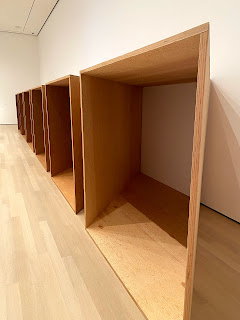 |
| A series of five parallelograms on view in a special exhibition on the artist Judd. |
 I am an educator and a writer. I was born in Louisiana and I now live in the Big Apple. My heart beats to the rhythm of "Ain't No Place to Pee on Mardi Gras Day". My style is of the hot sauce variety. I love philosophy sprinkles and a hot cup of café au lait.
I am an educator and a writer. I was born in Louisiana and I now live in the Big Apple. My heart beats to the rhythm of "Ain't No Place to Pee on Mardi Gras Day". My style is of the hot sauce variety. I love philosophy sprinkles and a hot cup of café au lait.
28.8.20
Journal & Rant: That Time I Joined a Pick-Up Basketball Game at Rainey Park in Queens
In this post, we talk about a local pick-up game of basketball at Rainey Park in Queens.
I don't play basketball. I don't play any sport, actually. However, I have recently taken to walking. I walked to Rainey Park this past weekend to attend my friend's birthday — it was completely outdoors in a park in Astoria, Queens that lies adjacent to the East River. You can see Roosevelt Island — and there is a small basketball court. The kids from the party started their own pick-up game and I took a few photographs. Can you spot the fake basketball?
 I am an educator and a writer. I was born in Louisiana and I now live in the Big Apple. My heart beats to the rhythm of "Ain't No Place to Pee on Mardi Gras Day". My style is of the hot sauce variety. I love philosophy sprinkles and a hot cup of café au lait.
I am an educator and a writer. I was born in Louisiana and I now live in the Big Apple. My heart beats to the rhythm of "Ain't No Place to Pee on Mardi Gras Day". My style is of the hot sauce variety. I love philosophy sprinkles and a hot cup of café au lait.
13.8.20
Photographs: Red Mask, Red Flowers, Pedestrians in Queens
Found these in my camera roll and I'm surprised by the shades of red found herein. It's hot and muggy here in New York. But flowers are abloom. I notice signs of humanity — a mother and son crouch together on the median on the 37th Avenue pedestrian zone and talk. A pile of police officers, eight or ten of them, stand in front of an apartment building, one holding what looks like a silver revolver 🔫. ”It’s fake, ” the officer says calmly. ”Found it here?” I ask. They did — after someone had called it in. A boy and a girl practice ollies on the street. I had hoped to use a camera to capture some of these moments. But I was too caught up in the moment.
 I am an educator and a writer. I was born in Louisiana and I now live in the Big Apple. My heart beats to the rhythm of "Ain't No Place to Pee on Mardi Gras Day". My style is of the hot sauce variety. I love philosophy sprinkles and a hot cup of café au lait.
I am an educator and a writer. I was born in Louisiana and I now live in the Big Apple. My heart beats to the rhythm of "Ain't No Place to Pee on Mardi Gras Day". My style is of the hot sauce variety. I love philosophy sprinkles and a hot cup of café au lait.
